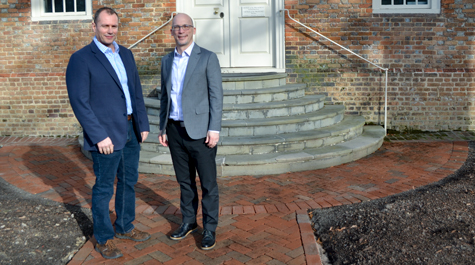IIC goals: A pathway for William & Mary students to address conservation issues on the ground
The leaders of William & Mary’s Institute for Integrative Conservation envision their nascent enterprise as a smooth pathway to the empowerment of students with the knowledge and skills to engage in the knotty environmental issues of the 21st century.
John Swaddle expects the IIC to have its own undergraduate curriculum in about three years. He’s already talking about adding a graduate certificate.
But Swaddle stresses that the Institute is not a strictly academic endeavor. A major aspect will be developing research collaborations with external organizations.
“They’re going to be conservation NGOs, largely,” he said. “A big goal is to put William & Mary faculty, staff and students in positions where they can make positive contributions to conservation on the ground.”
Swaddle, a behavioral biologist, will serve as faculty director of the IIC. Rob Rose, who heads William & Mary’s Center for Geospatial Analysis, is the institute’s executive director. The IIC was launched in late 2019, supported by a $19.3 million gift from an anonymous alumna donor as part of the university’s For the Bold fundraising campaign.
The IIC will move into quarters on the second floor of the university’s recently acquired property at 332 N. Henry St. in Williamsburg once it’s renovated. But Swaddle and Rose aren’t waiting for their new quarters to start the Institute’s work.
Rose noted that they have already forged some collaborations, including partnership agreements with Conservation International. CI is an Arlington-based environmental organization that focuses on human interactions with natural ecosystems.
“We've been working with Conservation International already and we're going to have some student internships with CI this summer,” Rose said.
He cited an example: a set of internships centered around zero-deforestation commitments, promises made by corporations that deal in extractive resources.
“For example, companies that are growing palm oil in Indonesia issue these zero deforestation commitments,” Rose explained. “I had students that were looking at this as part of a class project. We've now connected them to Conservation International and we’ll be able to do this on a bigger scale, seeing how these commitments play out in the field.”
Many of the IIC collaborations will have a broad focus, addressing not only conservation issues, but also related economic, land rights and social questions, as in the palm oil collaboration. Therefore, the focus of the IIC mission is necessarily interdisciplinary and it falls directly under the aegis of William & Mary’s chief academic officer Provost Peggy Agouris.
“The reason for the word ‘integrative’ is that we want to take a different approach to conservation,” Swaddle explained. “Traditionally it's been centered in the sciences. We want to take a much broader view of conservation and build in business processes, strategic leadership, and the rights of indigenous peoples, as many conservation problems stem from the conflict involving economic development in developing nations.”
Swaddle said the curriculum will be developed within the next three years. The curriculum will include traditional conservation-oriented subjects such as biology, geology and data science. He added that there will be a significant technological component.
“There’s so much information out there,” he noted. “How can that information be converted and used in ways that make sense for conservation action?”
The IIC coursework also will include training in finance, accounting and business practices, especially as they pertain to NGO operation. Other aspects will include international environmental law. Another important component will be an understanding of indigenous cultures.
“Because a lot of effective and sustainable conservation action is really about influencing collective human behavior. It's not only about focusing on the wildlife or even the habitat itself,” Swaddle said. “It's about sustaining communities in environmentally sensitive localities.”
















